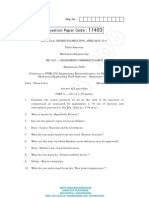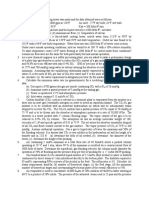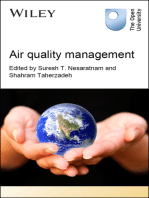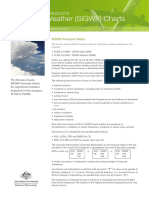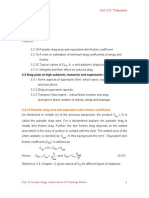EN4554/CV4554 Air Pollution Control Engineering: Tutorial 1
Uploaded by
zzz_monsterEN4554/CV4554 Air Pollution Control Engineering: Tutorial 1
Uploaded by
zzz_monsterEN4554/CV4554 Air Pollution Control Engineering
Tutorial 1
1. Estimate the collection efficiency required for a fluoride scrubber at a wet-process
phosphoric acid plant that must meet the air pollution control standard of 10.0 g/t of P2O5
feed. Assume that uncontrolled emissions would be about 120 grams of fluorides per
tonne of P2O5 feed.
2. Calculate the daily emissions of particulates from a new 1000 megawatt (MW) coal-fired
power plant that must meet the performance standards of 13.6 mg/million Btu. Assume
the coal has a heating value of 24,000 Btu/kg. The plant is 39% efficient. Determinate
the amount coals to be needed.
3. Exactly 500.00 ml of carbon monoxide (CO) is mixed with 999,500 ml of air. Calculate
the resulting concentration of CO in ppm. Exactly 500.00 ml of CO is mixture with 1,000
m3 of air. Calculate the resulting concentration of CO in ppm.
4. Dry air can be considered to be 78% nitrogen (MW = 28), 21.0% oxygen (MW = 32) and
1.0% argon (MW = 40). Calculate the average molecular weight of air and the density of
air at standard condition (T = 25 oC, P=1 atm).
5. Convert 0.1 parts per million by volume (ppmv) NO2 to µg/m3 at 20 oC and 750
torr. Convert 100 µg/m3 ozone at 25oC and 765 torr to parts per billion by volume
(ppbv).
6, How many µg/m3 is 100 ppb of SO2? Assume the atmospheric temperature and
pressure are 20 oC and 1 atm respectively.
7. Using the –dp/dh = ρg expression, calculate the pressure at 610 meters in the
atmosphere. Where p is pressure, h is the altitude (height), ρ is the density of air, g is
acceleration due to gravity. Assume the temperature change between 0 to 610 meters
is neglectable. Viscosity of air is same along height. Density of air is 1300 g/m3 and
same along height.
8. PSI has been used to identify our day-to-date are quality. If the PSI value is 55 what are
the subindices that contribute to air quality?
9. A sample stream of dry gas being withdraws from a stack. The stack gases are at 200
o
C and 730 mmHg. The stream flows through a heated flitter a set of cool traps (20 oC)
a small air pump and then through a flow meter. The rate of flow s determined to be
30.0 liters/minute at 20 oC and 790 mmHg. (a) Calculate the actual volumetric flow rate
through the flitter at 200 oC and 730 mmHg. (b) If 1.42 mg of sold particles are collected
on the flitter in 30 minutes, calculate the concentration of particles in the stack gas in
µg/m3.
10. What is air pollution? How can we prevent the damaging effects of air pollution? Explain
the implications of the Kyoto Agreement for the greenhouse effects
You might also like
- Philippine Science High School Qualifying Exam79% (127)Philippine Science High School Qualifying Exam19 pages
- Regular Paper 2 - Set A: Section - Ii: Short Descriptive QuestionsNo ratings yetRegular Paper 2 - Set A: Section - Ii: Short Descriptive Questions23 pages
- Exercise 1: Practice On Mass Balances: Figure 1 Role of Hoods in An Industrial ProcessNo ratings yetExercise 1: Practice On Mass Balances: Figure 1 Role of Hoods in An Industrial Process2 pages
- CE-105 12 Air Pollution - Numerical Problems 10% (1)CE-105 12 Air Pollution - Numerical Problems 18 pages
- Air Pollution Tutorial Questions_Solutions - CopyNo ratings yetAir Pollution Tutorial Questions_Solutions - Copy8 pages
- Week 7_ Class 3_Air Pollution Calculations_2024No ratings yetWeek 7_ Class 3_Air Pollution Calculations_202416 pages
- Process_Calculation_1990_to_2024__1729579211494No ratings yetProcess_Calculation_1990_to_2024__1729579211494104 pages
- CHE4162-Set 9-Solutions Ch15 Dust ExplosionNo ratings yetCHE4162-Set 9-Solutions Ch15 Dust Explosion3 pages
- End Sem Questions CLPC 11 Process CalculationsNo ratings yetEnd Sem Questions CLPC 11 Process Calculations2 pages
- Introduction To Air Pollution - WorkbookNo ratings yetIntroduction To Air Pollution - Workbook10 pages
- L1 Air Source Classification MeteorologyNo ratings yetL1 Air Source Classification Meteorology93 pages
- Me6301 Engineering Thermodynamics May June 2011No ratings yetMe6301 Engineering Thermodynamics May June 20113 pages
- Calculations: 1. Air Flow Calculations, According To Natural Draft Pressure CalculatorNo ratings yetCalculations: 1. Air Flow Calculations, According To Natural Draft Pressure Calculator4 pages
- Refresher: Power & Industrial Plant Engineering PIPE - VIP - 01No ratings yetRefresher: Power & Industrial Plant Engineering PIPE - VIP - 01121 pages
- Encyclopaedia Britannica, 11th Edition, Volume 8, Slice 3 "Destructors" to "Diameter"From EverandEncyclopaedia Britannica, 11th Edition, Volume 8, Slice 3 "Destructors" to "Diameter"No ratings yet
- Environmental Scenario in Indian Mining Industry - an OverviewFrom EverandEnvironmental Scenario in Indian Mining Industry - an OverviewNo ratings yet
- Factors in The Proportioning of Quality Concrete Mixtures: Workability StrengthNo ratings yetFactors in The Proportioning of Quality Concrete Mixtures: Workability Strength54 pages
- Chapter 1 Numerical Interpolation and DifferentiationNo ratings yetChapter 1 Numerical Interpolation and Differentiation38 pages
- Cv4201 - Civil Engineering Management Resources Planning & ManagementNo ratings yetCv4201 - Civil Engineering Management Resources Planning & Management9 pages
- Strip Method - Alternative Load Dispersion (Discontinuity) LinesNo ratings yetStrip Method - Alternative Load Dispersion (Discontinuity) Lines1 page
- Civil Engineering Construction Technology CV4251 TUTORIAL #3, #4 and #5No ratings yetCivil Engineering Construction Technology CV4251 TUTORIAL #3, #4 and #53 pages
- CE5604-Advanced Concrete Technology: - History and Origins - Greeks: Addition ofNo ratings yetCE5604-Advanced Concrete Technology: - History and Origins - Greeks: Addition of27 pages
- Cv4201 - Civil Engineering Management Operational Research Techniques - Network AnalysisNo ratings yetCv4201 - Civil Engineering Management Operational Research Techniques - Network Analysis14 pages
- Nanyang Technological University School of Civil & Environmental EngineeringNo ratings yetNanyang Technological University School of Civil & Environmental Engineering11 pages
- CE5509 Advanced Structural Steel Design: Learning ObjectivesNo ratings yetCE5509 Advanced Structural Steel Design: Learning Objectives23 pages
- Cv4201 - Civil Engineering Management: DR Wong Wai Fan, Associate Professor, NTUNo ratings yetCv4201 - Civil Engineering Management: DR Wong Wai Fan, Associate Professor, NTU11 pages
- EN4554/CV4554 Air Pollution Control Engineering: Tutorial 2No ratings yetEN4554/CV4554 Air Pollution Control Engineering: Tutorial 22 pages
- Nanyang Technological University School of Civil and Environmental EngineeringNo ratings yetNanyang Technological University School of Civil and Environmental Engineering4 pages
- CV 4201 Lecture RT1 On Financial Planning (1) - Jan 07No ratings yetCV 4201 Lecture RT1 On Financial Planning (1) - Jan 0710 pages
- Cv4201 - Civil Engineering Management Acts & Regulations Governing Professional Civil Engineering Practice in SingaporeNo ratings yetCv4201 - Civil Engineering Management Acts & Regulations Governing Professional Civil Engineering Practice in Singapore31 pages
- (Celtech College) : Sci 1: Earth & Life ScienceNo ratings yet(Celtech College) : Sci 1: Earth & Life Science7 pages
- Lesson Plan For CO2 Science 7 Final Hot AirNo ratings yetLesson Plan For CO2 Science 7 Final Hot Air5 pages
- NGSS3D MSPS ThermalEnergyTransfer EXPLAIN STEMscopediaNo ratings yetNGSS3D MSPS ThermalEnergyTransfer EXPLAIN STEMscopedia7 pages
- CBSE Sample Paper Class 9 Science Set 2 SolutionNo ratings yetCBSE Sample Paper Class 9 Science Set 2 Solution7 pages
- An 112 Magnos28 Oxygen Purity Measurement enNo ratings yetAn 112 Magnos28 Oxygen Purity Measurement en3 pages
- Let's Check: Activity 1.1. TRUE or FALSE. Write TRUE If The Statements AreNo ratings yetLet's Check: Activity 1.1. TRUE or FALSE. Write TRUE If The Statements Are6 pages








































